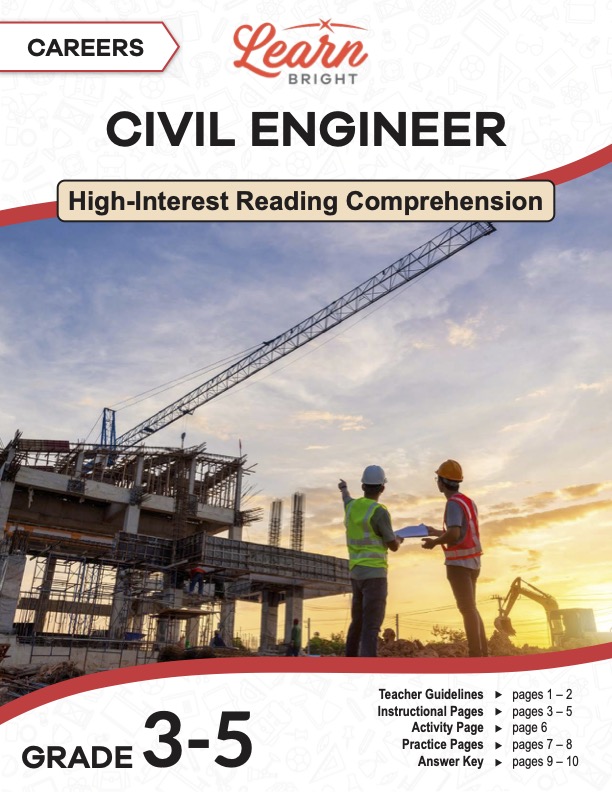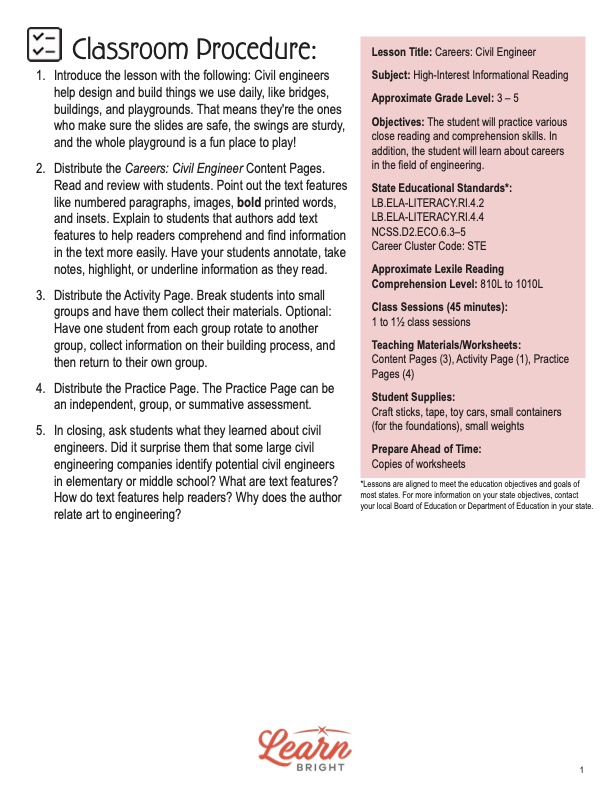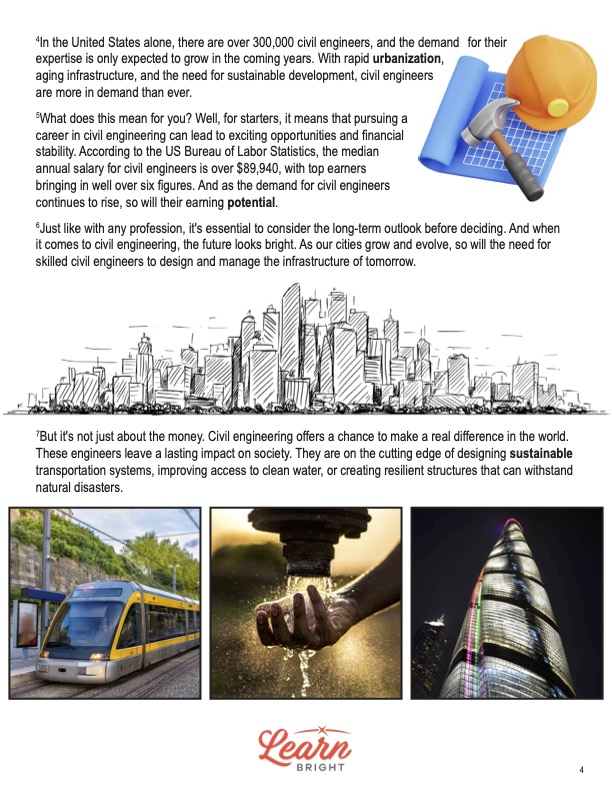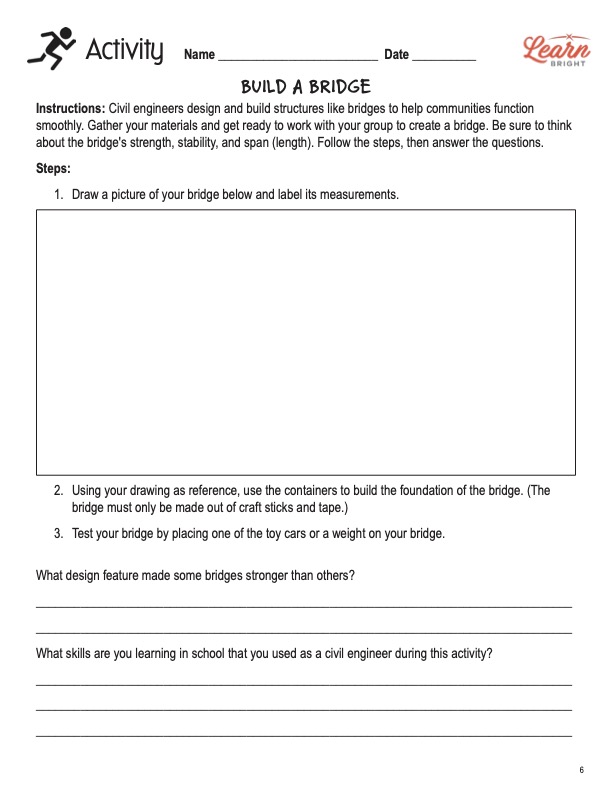Description
What our Careers: Civil Engineer lesson plan includes
Lesson Objectives and Overview: Careers: Civil Engineer is a high-interest reading comprehension lesson plan. As such, students will practice various close reading and comprehension skills. In addition, the student will learn about careers
in the field of engineering. This lesson is for students in 3rd grade, 4th grade, and 5th grade.
Classroom Procedure
Every lesson plan provides you with a classroom procedure page that outlines a step-by-step guide to follow. You do not have to follow the guide exactly. The guide helps you organize the lesson and details when to hand out worksheets. It also lists information in the yellow box that you might find useful. You will find the lesson objectives, state standards, and number of class sessions the lesson should take to complete in this area. In addition, it describes the supplies you will need as well as what and how you need to prepare beforehand. The materials you will need for the activity are craft sticks, tape, toy cars, small containers (for the foundations), and small weights.
Teacher Notes
The teacher notes page provides an extra paragraph of information to help guide the lesson and remind you what to focus on. It explains that you can teach this lesson in a whole-class setting or as an independent, small-group activity. The blank lines on this page are available for you to write out thoughts and ideas you have as you prepare the lesson.
CAREERS: CIVIL ENGINEER LESSON PLAN CONTENT PAGES
What Is a Civil Engineer?
The Careers: Civil Engineer lesson plan contains three content pages. You might be wondering why anyone would talk to you about becoming a civil engineer when you’re just a kid. But let me tell you, it’s never too early to start thinking about your future career path. Whether you’re still in elementary school or nearing the end of high school, now is the perfect time to begin exploring different professions. It’s good to start figuring out what interests you. And you might discover that civil engineering is a field worth considering for yourself.
If you’ve ever seen massive bridges stretching across rivers, towering skyscrapers piercing the skyline, or intricate highway systems weaving through cities, you already have a glimpse of what civil engineers do. Civil engineers are like beavers because they construct structures to support their community. They are the masterminds behind much of the design, construction, and maintenance of nearly every structure you see. Civil engineers play a role in shaping our world, from roads and bridges to buildings, roller coasters, and water treatment plants.
Imagine a world without civil engineers. There would be no safe roads to drive on, no sturdy buildings to live and work in, and no clean water to drink. The infrastructure we often take for granted is all thanks to the innovative work of civil engineers. And think of ancient buildings like the pyramids or the Roman Colosseum. Even those were the work of early civil engineers!
What to Expect from this Career
In the United States alone, there are over 300,000 civil engineers, and the demand for their expertise is only expected to grow in the coming years. With rapid urbanization, aging infrastructure, and the need for sustainable development, civil engineers are more in demand than ever.
What does this mean for you? Well, for starters, it means that pursuing a career in civil engineering can lead to exciting opportunities and financial stability. According to the US Bureau of Labor Statistics, the median annual salary for civil engineers is over $89,940, with top earners bringing in well over six figures. And as the demand for civil engineers continues to rise, so will their earning potential.
Just like with any profession, it’s essential to consider the long-term outlook before deciding. And when it comes to civil engineering, the future looks bright. As our cities grow and evolve, so will the need for skilled civil engineers to design and manage the infrastructure of tomorrow.
But it’s not just about the money. Civil engineering offers a chance to make a real difference in the world. These engineers leave a lasting impact on society. They are on the cutting edge of designing sustainable transportation systems, improving access to clean water, or creating resilient structures that can withstand natural disasters.
Education and Interests
So, what does it take to become a civil engineer? Well, it all starts with a solid education. Most civil engineers like math and anything related to creative design in school. For example, when interviewed, many said their two favorite subjects were math and art! Civil engineers hold a bachelor’s degree in civil engineering or a related field. Additionally, many pursue advanced degrees or certifications to specialize in a particular area of civil engineering, such as structural engineering or environmental engineering.
In addition to formal education, civil engineers also gain practical experience through internships, co-op programs, or entry-level positions. This hands-on training is invaluable for developing the skills and knowledge needed to succeed. Some students intern in middle or high school with engineering firms to learn about the career from the inside. Then, they pursue a degree when they go to college. Big engineering firms begin identifying potential engineers in elementary and middle school. They focus their recruitment on the students who like math, science, and STEM classes.
A career in civil engineering offers a combination of financial stability, professional growth, and the opportunity to positively impact the world. If you’re looking for a rewarding and fulfilling career path, consider becoming a civil engineer. You might help build the next iconic landmark, a sports arena, or the roads you and your family will drive on!
CAREERS: CIVIL ENGINEER LESSON PLAN WORKSHEETS
The Careers: Civil Engineer lesson plan includes two worksheets: an activity worksheet and a practice worksheet. Each one will help students solidify their grasp of the material they learned throughout the lesson. You can refer to the classroom procedure guidelines to know when to hand out each worksheet.
BUILD A BRIDGE ACTIVITY WORKSHEET
For the activity, students will get to put their engineering skills to the test and build a bridge. They will gather the materials you provide and work with a group to design and build the structure. After they test the bridge’s durability, they will answer a couple questions at the bottom of the page.
CAREERS: CIVIL ENGINEER PRACTICE WORKSHEET
The practice worksheet requires students to answer a series of 10 questions. These questions all relate to the content pages, so students will need to refer to them often for the answers. In addition, each question provides which reading tool the question corresponds to, such as text feature, vocabulary, or comprehension.
Worksheet Answer Keys
At the end of the lesson plan document is an answer key for the practice worksheet. The correct answers are all in red to make it easier for you to compare them with students’ responses. If you choose to administer the lesson pages to your students via PDF, you will need to save a new file that omits these pages. Otherwise, you can simply print out the applicable pages and keep these as reference for yourself when grading assignments.









